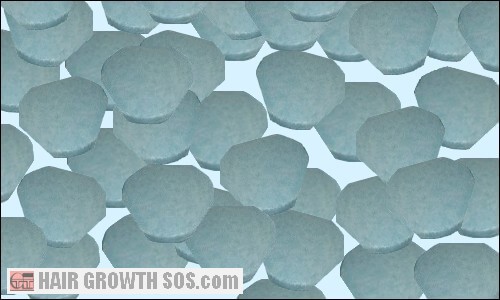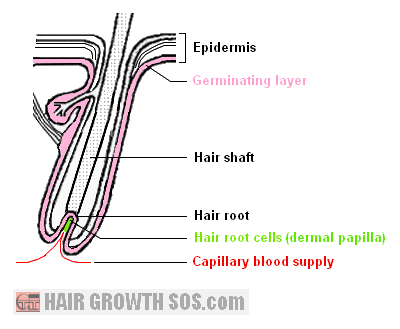Finasteride For Hair Loss: Can It Reverse miniaturized hair follicles?
By Paul Taylor
Thinking about taking finasteride for hair loss? Then you should know that it cannot reverse miniaturized hair follicles (1).
It's quite well known that finasteride (Propecia or Proscar) can help reduce the rate at which hair loss develops and might even encourage hair regrowth for some people.
And it's also quite well known that the hormone dihydrotestosterone (DHT) is linked to this type of hair loss (androgenetic alopecia).
But what isn’t too well known is that DHT should promote hair growth, not hair loss. This steroid hormone is used by the body to stimulate the growth of bone, muscle and hair.
I firmly believe that the primary effect of DHT in the hair loss process is that it contributes to skull expansion by stimulating certain skull bones to grow.
I also believe that DHT has a secondary effect in the hair loss process.
This article explains what this secondary effect is, and how the use of finasteride for hair loss treatment only provides some resistance to it.

Hair Loss, DHT and Finasteride
The eight points below show how the hair loss process develops (point 1), how the secondary effect of DHT then makes hair loss even worse (points 2 to 7), and how finasteride then tries to tackle it (point 8). Please also refer to the color-coded diagram below.
1. Hair loss starts when skull expansion of the frontal and parietal bones causes a reduction in the capillary blood supply to hair follicles in the affected region of the scalp. Hair follicle miniaturization and hair loss then follow.
2. The body doesn’t want to lose scalp hair, so it reacts through a process called upregulation (hyperandrogenicity). This basically means that the body tries to restore healthy hair growth by increasing DHT levels* in the follicles affected by skull expansion.
* Remember, that's what DHT does - it stimulates growth, not loss.
3. Higher DHT levels will accelerate mitosis (cell division) which should help struggling hair to grow.
4. But, when the rate of mitosis increases, the blood supply becomes insufficient to grow hair any thicker or faster (i.e., because skull expansion has reduced the capillary blood supply).
In other words, the hair root cells (dermal papilla) of the follicles fail to meet the growth demand placed upon them by DHT (see diagram below).

5. Since thick, rapid hair growth can’t occur, DHT then affects the germinating layer of the skin. And this can force skin cells to rise up and start shedding from the surface much faster than normal, causing dandruff.*
* This is why dandruff and hair loss can sometimes be connected - Read page 3 to learn more.
6. DHT also forces follicles to rush through the hair growth cycle faster than normal. And this means even more hair starts falling out.
7. The hair that falls out due to higher DHT levels should regrow during the next hair growth cycle.
But, further accumulation of DHT in the follicles will only serve to rush them through the cycle once again. And so, weaker and thinner hair will grow in successive hair growth cycles.
8. Finasteride treats this secondary effect of DHT by inhibiting 5-alpha reductase (an enzyme that converts testosterone into DHT).
So, by reducing DHT levels, finasteride extends the growing phase
of the hair growth cycle (anagen). And this, of course, allows more hair
to grow.
Should You Use Finasteride for Hair Loss?
Obviously that’s up to you. But there are three potential problems you should know about before you try finasteride for hair loss:
1. Upregulation - Further upregulation can occur if you take finasteride. Basically, the body can compensate for the effect on 5-alpha reductase forced upon it by finasteride. This means it tries even harder to increase the quantity of 5-alpha reductase and DHT production in the affected region of the scalp.
Many men do experience this upregulation when they
start taking finasteride for hair loss. And this explains why there can
be an initial increase in hair loss when they start using it, and again
when/if they stop.
2. Side effects – Remember, finasteride is a drug, so there is a risk of developing various other side effects. Learn about finasteride side effects?
3. Effectiveness - Finasteride does not reverse already miniaturized hair follicles*.
I believe that’s because it does not effectively treat the skull expansion process (i.e., the underlying cause of hair follicle miniaturization). It only addresses the negative effects caused when the body increases DHT production.
* A 2006 study (1) states: "In our study, there was no clear evidence in favour of reversal of miniaturized hair into terminal hair."
An Alternative To Finasteride?
I developed and successfully used my own hair regrowth techniques. Techniques that are an alternative approach to drug treatment, which have no side effects whatsoever, and do address the skull expansion process.
Furthermore, they have also helped thousands of other men and women save their hair too, including the person who sent me the very interesting email below:
"Today I went to the dermatologist to get some prescriptions for my dry scalp.
He still had my record and reminded me
how I asked him about Propecia the last time I was in. I told him
definitely not, and he actually was like: "good I don't like that
stuff, it's the most popular stuff out there and most of the time it
doesn't even work".
I almost wanted to tell him about what I've been doing the last few months*
but I decided against it. It was just a good feeling that there is a
doctor out there who doesn't recommend the hair loss industry's main
drug."
Mr D. Hildebrand, USA
* Re: "what I've been doing the last
few months" - He's referring to the method mentioned above, and is very happy with the progress he's making. Learn about this method?
There are other negative effects of DHT caused by its interference with normal cell division including those explained on the next page.
This is page 2 of 3.
Read final page? Does dandruff cause hair loss?
Read previous page? How DHT causes cell death in hair follicles.
|
Like this page? |
|

